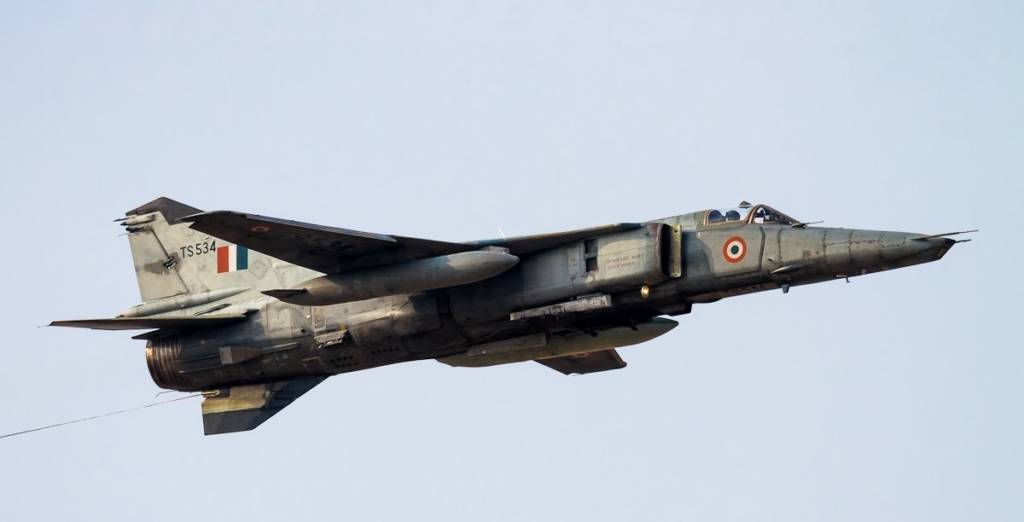In what can be described as the end of an era, the Indian Air Force (IAF) has decommissioned its Kargil war hero MiG-27 at a de-induction ceremony held at the Jodhpur airbase held today. The iconic fighter jet has served the Indian Air Force for over three decades and the MiG 27 fleet had its last sortie from the Jodhpur airbase today. India had a total of 165 MiG 27 aircraft, all of them manufactured by the Defence PSU, Hindustan Aeronautics Limited (HAL) under license. Only 15 of these aircraft remain now. Having been de-inducted today, most of these remaining aircraft will be used as decoys in multiple airbases in the Western Air Command, while some of them will also be gifted to various interested institutions as well.
Throughout its service of three decades, MiG-27 proved to be the mainstay of the IAF. The single-engine, single-seater, ground strike aircraft is chiefly remembered for its role in the Operation Safer Sagar during the Kargil war. In fact, the fighter had earned the nickname ‘Bahadur’ from IAF pilots for its role in pounding the enemy positions. In fact, Kargil war hero, Group Captain Kambampati Nachiketa Rao, who was taken captive by Pakistani troops during the Kargil war, was also flying a MiG-27 fighter aircraft.
Highlighting the glorious history of the aircraft, Commodore Philip Thomas, Air Officer Commanding of the Jodhpur airbase, told The Print, “The aircraft has a glorious history, and this is the last of the MiG-23/MiG-27 class variable-sweep (swing-wing) Russian-origin aircraft operating in the world.” A feared fighter aircraft of its times, MiG-27 could touch a maximum speed of 1,700 km/h (Mach 1.6). It carried one 23mm six-barrel rotary integral cannon, and also had the capacity of carrying up to 4,000 kg of other armament externally.
MiG-27 was designed as an all-new, strike-minded variant of the MiG-23. It retained the NATO name, “Flogger” as the MiG-23, which it was derived from. MiG 27 lent the swing-wing capabilities from the original “Flogger”, MiG-23 for low-level activities and short take-off and landings which are inherent in the close-support role. The first flight was achieved in 1972, and the first available examples of the aircraft were shipped to Germany as a show of strength against the NATO forces there.
In the Indian context, MiG 27 fighter was inducted in the Indian Air Force (IAF) in the year 1985 and was later upgraded in the year 2005. While the airframe remained the same, there were changes in the avionics and instrumentation upgrades, as well as weapons upgrade enabling it to fire precision ammunition. The Defence Ministry has said, “The upgraded variant of this last swing-wing fleet has been the pride of IAF strike fleet since 2006. All other variants, such as MiG-23 BN and MiG-23 MF and the pure MiG-27 have already retired from IAF.” It added, “The fleet earned its glory in the historic Kargil conflict when it delivered rockets and bombs with accuracy on enemy positions. The fleet also took active part in Operation Parakram.”
Bidding adieu to the glorious aircraft, the IAF also tweeted, “#AdieuMiG27 Indian Air Force bids farewell to the mighty MiG-27 tomorrow. The aircraft will be decommissioned in a grand ceremony to be held at Air Force Station Jodhpur on 27 Dec 19.” It added, “This formidable ground-attack fighter aircraft has served the Nation for over three decades. Inducted in 1985, MiG-27 has been the mainstay of IAF’s ground attack capability. It has participated in all major #IAF operations and has played a stellar role in the 1999 Kargil War.”
This formidable ground attack fighter aircraft has served the Nation for over three decades. Inducted in 1985, MiG-27 has been the mainstay of IAF's ground attack capability. It has participated in all major #IAF operations and has played a stellar role in the 1999 Kargil War. pic.twitter.com/sHke9FCEKI
— Indian Air Force (@IAF_MCC) December 26, 2019
MiG-27 played a stellar role throughout its association with the IAF. Its de-induction therefore really means the end of a glorious era in the magnificent history of the IAF.
